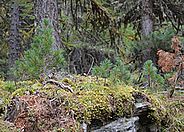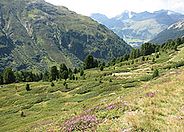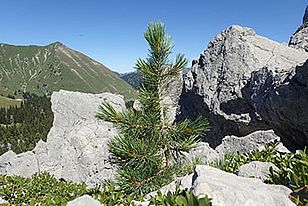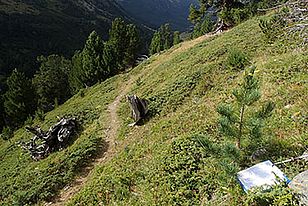PiCadapt
2014 - 2034
Cooperation FinancingAdaptive genetic variation of Swiss stone pine in response to environmental gradients across the Alpine timberline ecotone
PiCadapt aims to study gene-encoded nucleotide variation in the bird-dispersed Swiss stone pine (Pinus cembra), a keystone tree species of the Alpine timberline ecotone, in response to environmental gradients.


Studying patterns and mechanisms of local adaptation at the genomic level is a key to a better understanding of how species may cope with environmental change in the future. In the recent past, various studies have investigated if and how individuals or populations are genetically adapted to local conditions. Most research efforts, however, are still devoted to model organisms, which are often of limited relevance from an ecological perspective. Moreover, it is still not clear whether and how locally adapted gene variants will be able to follow shifting habitats as a consequence of climate change.
To cope with ongoing climate warming, P. cembra requires colonizing new habitat above its current distribution, while extant rejuvenation already experiences environmental conditions that largely differ from those under which current adult populations established. Hence, we will collect juvenile and adult P. cembra samples along several altitudinal gradients in the Alps. Using RNA-seq, exome-capture, and single-nucleotide polymorphism (SNP) genotyping, we will identify and assess SNPs in a broad range of selected genes across the exome of P. cembra. This allows us to compare allele and genotype frequencies between adult and juvenile cohorts as well as between low- and high-elevation juvenile populations. We expect to find marked differences in presumably adaptive loci between these cohorts, mainly in response to divergent temperature and precipitation regimes.
Specifically, the study asks the following questions:
- Can we associate exome-based nucleotide polymorphisms with environmental variation along range-wide environmental gradients in P. cembra?
- Do adult and juvenile cohorts of P. cembra show differences in allele and genotype frequencies at candidate genes identified above?
- Do allele and genotype frequencies at putatively adaptive loci differ between juvenile P. cembra populations across elevational gradients?
- Are alleles that are considered to be adapted to low-elevation environments also present in juvenile populations of P. cembra at high elevations to match future climatic conditions?
- Can genetic polymorphisms that are associated with environmental variation in re-sequenced populations of P. cembra be validated in an extended set of populations across the Alps?

